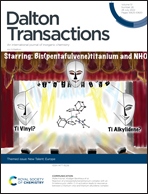Pyrolysis of a metal–organic framework followed by in situ X-ray absorption spectroscopy, powder diffraction and pair distribution function analysis†
Abstract
Metal–organic frameworks (MOFs) can serve as precursors for new nanomaterials via thermal decomposition. Such MOF-derived nanomaterials (MDNs) are often comprised of metal and/or metal oxide particles embedded on porous carbon. The morphology of MDNs is similar to that of the precursor MOF, and improved stability and catalytic properties have been demonstrated. However, the pathway from MOF to MDN is only well understood for a few systems, and in situ studies are needed to elucidate the full phase behaviour and time/temperature dependency. In this work, we follow the MOF-to-MDN transformation in situ by using three complementary techniques: X-ray absorption spectroscopy (XAS), powder X-ray diffraction (PXRD), and X-ray total scattering/pair distribution function (TS/PDF) analysis. The thermal decomposition of HKUST-1, i.e. the archetypical MOF Cu3(btc = 1,3,5-benzenetricarboxylate)2, is followed from room temperature to 500 °C by applying different heating ramps. Real space correlations are followed by PDF and extended X-ray absorption fine structure (EXAFS) analysis, and quantitative phase fractions are obtained by refinement of PXRD and PDF data, and by linear combination analysis (LCA) of X-ray absorption near edge Structure (XANES) data. We find that HKUST-1 decomposes at 300–325 °C into copper(I) oxide and metallic copper. Above 350–470 °C, metal particles remain as the only copper species. There is an overall good agreement between all three techniques with respect to the phase evolution, and the study paves the road towards rational synthesis of a Cu2O/Cu/carbon material with the desired metal/metal oxide composition. More importantly, our investigations serve as a benchmark study demonstrating that this methodology is generally applicable for studying the thermal decomposition of MOFs.

- This article is part of the themed collection: New Talent: Europe


 Please wait while we load your content...
Please wait while we load your content...